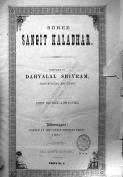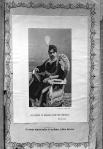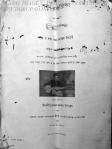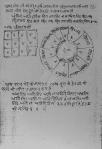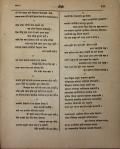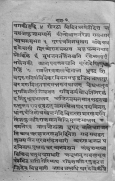Posts Tagged ‘Dhrupad’
The Search for Published and Unpublished Works on Dhrupad
In a dhrupad performance the exposition of the Raga through the abstract syllabic alap is followed by the singing of a composed melody with lyrics, set to a tala or a cycle of beats accompanied by a barrel drum – the pakhāwaj. Strictly speaking it is the composed melody, which usually has four parts, that bears the name dhrupad, although the term is now used to identify the entire genre including the alap. A Dhrupad Composition actually embodies within it all the principles of the music, and serves as a model of the exposition of the raga, composed by a master dhrupad singer not only for his own performance, but as a musical statement for subsequent oral transmission to succeeding generations. Compositions represent the fixed repertoire of Dhrupad and encapsulate the musical knowledge and wisdom of many generations of Dhrupad singers. Compositions were often created to illustrate specific aspects of the grammar of music. The lyrics of compositions contain a wealth of information about history, folklore, mythology, philosophy and the conceptual framework of music. In an oral tradition compositions of course mutate with time and one finds many different versions of the same composition prevalent in different traditions in different parts of the country.
Efforts to notate and publish books of Dhrupad compositions started in the 19th Century when mechanized printing came to India. Before the age of mass printing, singers had attempted to notate and keep their repertoire of compositions from being forgotten or distorted. However such works were mostly kept for personal reference and use, and access to them if at all permitted to others, was restricted to the closest disciples or relatives of the author. The compilation Sangeet Samuccaya done by Beenkar Shivendranath Basu in 1924 mentions that Dulahsen or Budhprakash – a descendant of Tansen wrote a work notating compositions of his tradition which remained with his descendants. Many such works remained in private hands zealously guarded from the public and eventually it may be presumed that many such works were lost or destroyed. I personally know of a handwritten manuscript of Radheshyamji Sharma, son of Sitaramji Sharma- the pre-independence court musician of Tikamgarh, with notations of about 400 compositions of Dhrupad, which I briefly saw some years ago in the zealously guarded possession of a relative, which is now completely untraceable.
Most works were published with the support of wealthy patrons like Maharajas and Zamindars – like the Sangit Kaladhar of 1901 published by the Maharaja of Bhavnagar written by his court musician Dahyalal Shivram.
Many works were only partly published or could never be published at all because of a lack of funds. Like the Sangeet Sudha Sagar of Prankrishna Chattopadhyaya with compositions in uncommon Ragas, of which only a fraction of the first volume was printed by the author at his own expense in the 1950’s. The author a student of Tansen descendant Nihal Sen of Jaipur and of Dagar tradition singer Abban Khan of Pratapgarh, mentions in the preface that he has applied for State funding and hopes to publish the entire work with 240 compositions of the tradition of Tansen in the first volume. Since the author’s teacher Nihalsen was a descendant of Dulahsen it is quite probable that his work contained many of the compositions notated by Dulahsen in his manuscript.
My enquiries have revealed that the handwritten notes with his descendants got destroyed by termites. However the author did manage to get some State grants towards the end of his life and there is a small chance that a copy of the manuscript survives somewhere. The first volume of the Sangeet Samuccaya mentions that the second volume with 200 compositions is being printed and the author mentions that he has managed to collect notations of more than a thousand compositions. However the second volume never actually got printed. The work was being published by the Nagri Pracharini Sabha the predecessor of Bharat Kala Bhavan Varanasi which underwent major changes and a shift of venue in the late 1920s. It is a major task now to locate the unpublished parts of of works like the Sangeet Sudha Sagar and the Sangeet Samuccaya if they still survive.
With most of the repertoire of compositions of Dhrupad now lost or fragmented and distorted, it is a work of great importance to try to save whatever survives of books and unpublished manuscripts. Manuscripts of unpublished works that still survive have to be found, digitized and published. One can see from studying works written decades ago how ragas have gradually changed over time. Dhrupad singers who are traditionally trained and steeped in the knowledge of tradition can then use their training to reconstruct repair and restore compositions that have been distorted or lost and bring them back to life.
These works contain not only compositions but sargam and prastara exercises, instrumental gats, pakhawaj bols and a wealth of information on the concepts and grammar of music. They reveal unique insights into the concepts of music. For instance the Sarod Rasa Chandrika of 1938 written by a student of Tansen descendant Sarod player Amir Khan gives numerous instrumental compositions classified according to the four banis of Dhrupad. One of the rare instances of classification of compositions according to banis.
The complex charts and diagrams and the cryptic terminology in the handwritten Laya Prashna of Kudao Singh the originator of the Kudao Singh style of pakhawaj are scarcely intelligible to pakhawaj exponents today, yet similar diagrams and explanations in the Tala section of the Nad Vinod Granth of 1896 of Pannalal Goswami might give us the key to understanding Kudao Singh’s methods.
Texts like the Rag Prakash and Raga Kalpadrum give listings of texts of Dhrupad compositions and are invaluable for removing textual distortions in compositions as also reconstructing lost parts from fragments that survive in the oral tradition or in recordings.
I have over the last 30 years tried to find and digitize published and unpublished works with my own resources and hope that sometime soon a well funded systematic initiative can be launched to carry out this task on a war footing. Along with the digitization what needs to be done is a detailed indexing and creation of a database of all available material including audio and video recordings which dhrupad practitioners could use to regain lost knowledge.
On this link can be found a partial list of works that I have managed to digitize – Rare Books on Dhrupad . In the videos below are several examples of Dhrupad compositions that I found in such rare books and developed using my knowledge from tradition to use in my performances and teaching. – The main cost involved in the work of looking for rare books and manuscripts is of course travel. Many of the rare books have been found in the dusty shelves of old libraries and private collections in small towns. There are many places I need to go to – Lucknow, Baroda, Dhar, Ujjain, Calcutta to follow up leads. Donations supporting this work are welcome. Ashish Sankrityayan
Kathak Choreography by Vidyagauri Adkar to a Composition of Chaturbiharidas in Four Parts in Raga Barwa Tala Sultaal from Sangeet Chandrika of Gopeshwar Banerjee, Khajuraho Festival of Dances 2014
……………………………………………………………………………………………………………………………………….
Odissi Choreography by Bithika Mistry to a Composition of Swami Haridas in Four Parts in Raga Bhimpalasi Tala Tivra from Sangeet Manjarl of Ramprasanna Banerjee, Khajuraho Festival of Dances 2014
……………………………………………………………………………………………………………………………………….
Students of Ashish Sankrityayan Sing a Composition in Four Parts of Suratsen in Raga Yaman Tala Sultal from Sangeet Manjarl of Ramprasanna Banerjee
All articles on this blog © Ashish Sankrityayan. No part may be used except with written permission and explicit acknowledgement.
Elder Dagar Brothers – Ahmadjan Thirakwan Tabla – Bihag
A rare recording of the Elder Dagar brothers Nasir Moinuddin and Aminuddin Dagar singing Bihag with Ahmadjan Thirakwan on Tabla. Recorded from a All India Radio Broadcast of a live concert early 1960s by Maharawal Mahipalsinghji of Dungarpur.
Reconstruction of Dhrupad Compositions with Four Parts
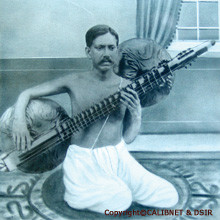 The compulsion of giving short performances in the kind of festivals that are organized nowadays with three or four artists sharing the stage and the audience not staying on till late and also the emphasis on improvisation is probably why often only one or at the most two parts of Dhrupad compositions are heard nowadays. Gradually the last two parts of many compositions have been forgotten since they are not often sung. However since the last two parts are essentially variations of the first two, it should be possible to reconstruct them if the entire text of the composition is available.
The compulsion of giving short performances in the kind of festivals that are organized nowadays with three or four artists sharing the stage and the audience not staying on till late and also the emphasis on improvisation is probably why often only one or at the most two parts of Dhrupad compositions are heard nowadays. Gradually the last two parts of many compositions have been forgotten since they are not often sung. However since the last two parts are essentially variations of the first two, it should be possible to reconstruct them if the entire text of the composition is available.
In books like the Dhrupad Swaralipi of Shri Harinarayan Mukhopadhyay published(1929) and available on the link, or the Geet Vadya Saar Sangraha of Charucharan Mukhopadhyaya (1905) or the Nad Vinod Granth of Pannalal Goswami 1896 can be found the complete texts of many such compositions.
For example though there is no recording of all the four parts of the composition Bansidhara Pinakadhara sung in the Dagar Tradition in Multani, we can find the song text in the Dhrupad Swaralipi and reconstruct the entire composition since the third part is essentially a close variation of the sthayi and always begins with a characteristic hudak ornament spanning a large part of the octave from the lower to the middle. The fourth part is essentially like the second with slight variations. The words of the last two parts of this composition as given in the book (in Raga Shree) are -chandanadhara bhasmadhara maalaadhara sheshadhara gopivara parameshwara gopishwara ishwara. kahe miya taansen dou swaroopa ek tuma garudasana vrishavahana teenaloka kara uddhara. The Raga Vigyan of Vinayakrao Patwardhan gives the following lyrics for the last two parts – nandidhara garudadhara kailasdhara vaikunthadhara kahe baiju baware sunahu gunijana nisadina harihara dhyana uradhara.
A well trained Dhrupad singer should be able to reconstruct compositions in this way. Which again brings us to the important task of collecting all recorded and written material on Dhrupad and going about reconstructing whatever is possible.
Another frequently heard composition whose 3rd and 4th parts can be found in the Geet Vadya Saar Sangraha and the Sangit Manjari of Ramprasanna Bannerjee of Vishnupur (1935) is – niranjana nirakara parabrahma parameshwara. ek hi anek hoye vyapyo vishambhara. alakha jyoti avinashi jyoti rupa jagatarana. jagannatha jagatapati jagajivana jagadhara. baahi mein sab jiva jantu suranara muni guni gyani. nabhi kamal te brahma pragatayo shataroopa manvantara. kahe baiju vahi brahma vahi virata roopa vahi. aap avataar bhaye chaubis vapudhara. The same composition can often be found in different Ragas in different traditions. The first book gives it in Raga Bhairava while the second lists it in Bhairavi.
Here is a recording of the Elder Dagar Brothers singing alap in Sudhdha Rishabh Chandrakauns followed by this composition in a Radio broadcast from the 1960s.
A later recording of the Younger Dagar Brothers has both the sthayi and antara
Here are two more compositions commonly heard in the Dagar tradition with the first two parts along with the texts of all the four parts from the Nad Vinod Granth which could again be reconstructed by singers who are well trained in the tradition.
First two parts of Chowtal Composition in Bhimpalasi sung by the Elder Dagar Brothers
Text of all four parts from Nad Vinod Granth. There is a variant of the same in the Dhrupad Swarlipi mentioned above.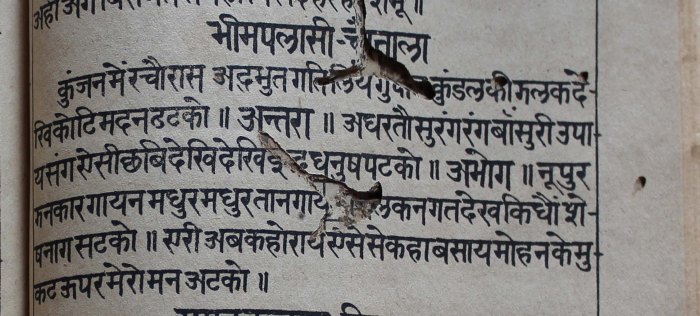
The first two parts of a Dhrupad composition in Raga Bhupali in Chowtal sung by the Elder Dagar Brothers
Text of all four parts from Nad Vinod Granth. 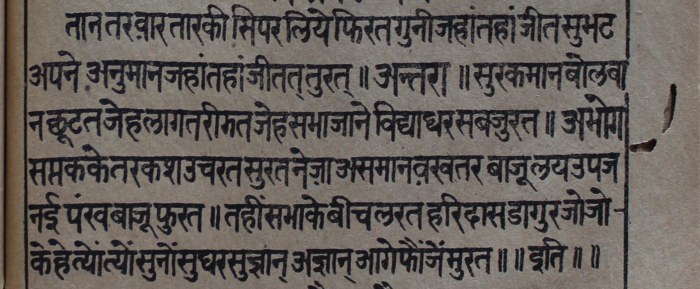
The Nad Vinod Granth is a valuable book with the texts of many dhrupad compositions and notations of instrumental gats and interesting prastara exercises in various Ragas. The notations of Ragas given in the book show how they have changed over more than a century. However the book would have been infinitely more valuable had the author also included notations of the Dhrupad compositions instead of notations of only the gats and the prastara exercises.
The photos in this post show Ramprasanna Bannerjee playing the Rudra Veena and his younger brother Gopeshwar Bannerjee of the Vishnupur Dhrupad Tradition. The world of Dhrupad will be eternally grateful to them for being farsighted enough to publish their two gem s with Dhrupad compositions – The Sangit Manjari and the Sangit Chandrika.
s with Dhrupad compositions – The Sangit Manjari and the Sangit Chandrika.
All articles on this blog © Ashish Sankrityayan. No part may be used except with written permission and explicit acknowledgement.
Dhrupad Compositions With Four Parts – Rahimuddin, Hussainuddin, Aminuddin, Zahiruddin and Faiyazuddin Dagar
One often hears it being said that singers of the Dagar Tradition do not sing all the four parts of a Dhrupad composition. The reason could be that the style lays much greater emphasis on improvisation and because of this, the last two parts being not sung often are gradually forgotten. Rahim Fahimuddin Dagar used to tell me that in a Dhrupad composition the first two parts the Sthayi and Antara were the most important – encompassing all the angs of the raga that the composition tries to demonstrate. The last two parts are essentially variations of the first two. Often due to the vagaries of the oral system of transmission and the peculiarities of the family relations and learning histories, some members of the Dagar family remembered all the four parts of certain compositions while others didn’t.
Another quirk of theirs is in the nomenclature of the four parts. The Dagars would insist that the last two parts of a Dhrupad composition are called Abhog and Sanchari and not the other way round. Fahimuddin Dagar told me that the third part always starts with a special ornament spanning a large part of the octave – the hudak and the fourth is more or less the same as the second – the Antara. He said the fourth part should be called the Sanchari or Samachari because it summarized the content of all the four parts and brought the composition to an end. He also added that it doesn’t really matter anyway if it is Abhog, Sanchari or the other way round.
When it came to remembering compositions the Late Nasir Aminuddin Dagar had probably the largest repertoire of them all. He also remembered many compositions of his maternal grandfather Inayat Khan. When I first met him in Calcutta, he spontaneously sang without tanpura accompaniment, several that I had never heard before. It is a real pity that he did not methodically record all that he remembered.
Here are two compositions by him with all the four parts.
Pujana Chali Mahadeva – Raga Malkauns – Chowtal, Composition of Tansen. Notice the tanpura tuning in Pancham. Something he insists on in the beginning before the alap as being required to preserve the tonal relations within the Raga.
Manus Hu To Vahi Ras Khan – Raga Kambhoji – Chowtal – text by Ras Khan – poet and Krishna devotee (16th – 17th century).
Another gem of a composition with four parts attributed to Tansen is Muraliya Kaise Baaje sung here by Nasir Zahiruddin and Nasir Faiyazuddin Dagar the younger sons of Nasiruddin Khan
Aminuddin Sab sings another composition with four parts in Raga Adbhut Kalyan which I recorded from a radio broadcast around 1990. He probably missed out a part of it somewhere since he has to repeat a phrase in the end to come to the first beat. He told me that the Raga was originally called Khem Kalyan. The composition is of Kalidas – the Pandit from whom his ancestor Behram Khan had learnt in Varanasi.
This composition in Todi sung by Hussainuddin Dagar (Tansen Pandey) mentions the names of Nayak Gopal and Nayak Baiju. The pakhawaj accompaniment is probably by S. V. Patwardhan of the Nana Panse school.
This composition in Lalit sung by Aminuddin Dagar mentions the name of Dhondi in the last part. The pakhawaj accompaniment is by S. V. Patwardhan. Recorded by Maharawal Mahipalsinghji of Dungarpur in 1966 from a radio broadcast.
Two more compositions with four parts are these in Miya Ki Malhar and Komal Rishabh Asavari by Rahimuddin Khan Dagar which are also there in his EP records released by HMV.
Raga Miya Ki Malhar
Raga Komal Rishabh Asavari
It is often difficult to understand the text from such recordings. The text of this Asavari composition can be found in vol 3 of Raga Sangraha of Master Krishnarao along with a notation that is more or less along the lines of the rendition of Rahimuddin Dagar. Popular compositions like this one remained in wide circulation in the oral tradition and the amazing thing is that usually the different versions agree in the overall structure and design despite coming from vastly different lineages of singers in widely separated parts of the country.

Young Aminuddin and Zahiruddin Dagar appear in this photo taken in 1936 in Indore – appearing solemn and downcast – understandable since their father Nasiruddin Khan had passed away a few months ago and their mother and elder brother Moinuddin had left for Jaipur. The little child in the lap of their uncle Rahimuddin Khan Dagar could be Faiyazuddin Dagar or one of their sisters – I am not sure. Standing between Zahiruddin and Aminuddin is young Fahimuddin Dagar.
The importance of Dhrupad compositions is that each is a model of the various angs or aspects of a raga – composed by a master Dhrupad singer and passed on from generation to generation as an example of the raga. Compositions document history, folklore, mythology, philosophical and musical concepts. Special compositions were created as pedagogical tools to illustrate certain concepts or methods of treatment. One huge task before us is to locate and digitize and make accessible to the public all existing material on Dhrupad.
The task would have been much easier 40 or 50 years ago when recording technology had become widely and easily available and there were many knowledgeable musicians still around. Right now the task is daunting if not overwhelming. Its a bit like embarking on an archaeological excavation without even knowing where to start digging.
Raga Kedar / Rahimuddin Dagar
Recording of Rahimuddin Dagar singing Raga Kedar – Brief Alap followed by the Dhamar “maana taja de ri aali aayo hai phaaguna maas’. (1950’s 6mins 37 secs)
Rahimuddin Dagar probably had the greatest mastery over the difficult voice technique of the Dagars among all who were recorded. Notice the effortless use of changing resonances in the voice. The Dhamar lyrics enjoin a beautiful maiden ( Radha?) to leave her reticence and join the revelry of holi. Notice the feeling of supplication in the words “maana taja” and the commanding tone of the “de’ while coming to the first beat – the sam.
Check these CDs and DVDs of Dhrupad on Cdbaby– Miya Ki Malhar —Abhogi and Lalit —Yaman and Malkauns
Photo from http://www.dhrupad.info/rahimuddin.htm where you will also find a brief biography of this maestro. An insightful account of Rahimuddin Dagar’s music has been given by S.K. Chaubey in his book ‘Musicians I have Met (1958)’ – Ustad Rahimuddin Khan by S.K. Chaubey
Recording from the personal archives of Ashish Sankrityayan



